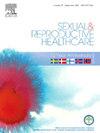Assessment of menstrual material needs as a measure of health and menstrual equity in the postpartum period
IF 1.7
3区 医学
Q3 PUBLIC, ENVIRONMENTAL & OCCUPATIONAL HEALTH
引用次数: 0
Abstract
Objective
To evaluate lochia management needs in a diverse cohort of postpartum individuals admitted for delivery at two large urban hospitals in the United States and to assess the association between immigration and menstrual needs.
Methods
English- or Spanish-speaking individuals delivering a live-born infant were recruited in this cross-sectional study via convenience sampling. We modified the Menstrual Practice Needs Scale to evaluate participant menstrual practices, menstrual poverty, preparedness for postpartum lochia, and experiences discussing menstrual material access with their healthcare team.
Results
There were 123 participants, 60 of whom were immigrants. Twenty-seven women (22 %) experienced menstrual poverty, and 10 were unsure if they had adequate materials to manage lochia. Women with an annual household income at or below the poverty level (p = 0.0004) or who had moved (p = 0.009) or experienced food insecurity (p < 0.0001) in the last year were more likely to have experienced menstrual poverty than those who had not. Half of participants never received lochia counseling. Only 15 women (12 %) had been asked by a healthcare member whether they had enough menstrual materials, but over a third wanted to discuss how to obtain them. The majority of women wanted to receive lochia management materials from their prenatal clinic and from the hospital.
Conclusions
Despite a high rate of menstrual poverty, women were rarely asked about access to menstrual supplies. These women want to discuss how to acquire menstrual materials with their healthcare team. Standardized screening and discussions about postpartum lochia may help to reduce postpartum menstrual poverty.
评估经期物质需求,作为产后健康和经期公平的衡量标准
目的评价在美国两家大型城市医院分娩的不同产后个体的恶露管理需求,并评估移民与月经需求之间的关系。方法采用方便抽样的方法,在横断面研究中招募英语或西班牙语产妇。我们修改了月经实践需求量表来评估参与者的月经实践、月经贫困、产后恶露的准备以及与医疗团队讨论月经物质获取的经验。结果共123人,其中移民60人。27名妇女(22%)经历经期贫困,10名妇女不确定她们是否有足够的材料来处理恶露。家庭年收入等于或低于贫困水平(p = 0.0004)或曾搬家(p = 0.009)或经历过粮食不安全(p <;0.0001)的女性比那些没有经历过月经不足的女性更有可能经历月经不足。一半的参与者从未接受过恶露咨询。只有15名妇女(12%)被保健人员询问过她们是否有足够的月经用品,但超过三分之一的妇女想讨论如何获得这些用品。大多数妇女希望从产前诊所和医院获得恶露管理材料。结论尽管经期贫困率很高,但妇女很少被问及获得经期用品的问题。这些女性希望与她们的医疗团队讨论如何获得月经用品。产后恶露的标准化筛查和讨论可能有助于减少产后月经贫困。
本文章由计算机程序翻译,如有差异,请以英文原文为准。
求助全文
约1分钟内获得全文
求助全文
来源期刊

Sexual & Reproductive Healthcare
PUBLIC, ENVIRONMENTAL & OCCUPATIONAL HEALTH-
CiteScore
2.70
自引率
5.60%
发文量
73
审稿时长
45 days
 求助内容:
求助内容: 应助结果提醒方式:
应助结果提醒方式:


